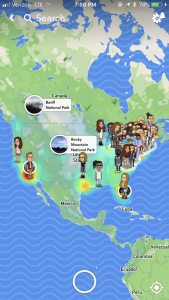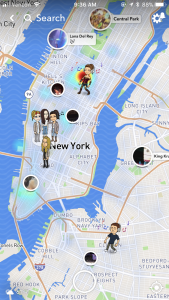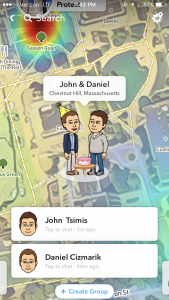Before this class, there were only two maps I interpreted regularly: an app called Maps and Snap Map. Maps assisted me in traveling from place to place while Snap Map had a more obscure purpose; Snap Map allowed me to stalk my friends. A little strange right?
On June 21, 2017, Snapchat–a technological powerhouse with over 500 million daily active users– introduced a new feature called Snap Map. Snap Map allows users to share their location around the world with mutual friends. In addition, it grants users access to see when the last time someone opened up the app. Of course, every person has the right to their own privacy and can turn off their location–which is referred to as “Ghost Mode”.
My personal experience with this map has evolved over time. First, like most people, I was weirded out that people could see where I was whenever I opened up snapchat, which is quite frequently. However, as I saw the growing popularity of people switching from private to public, my opinion on this map changed. I began to see the real intent of the map as a tool to stay connected with not only my friends, but the rest of the world. In a matter of seconds, I can click on a hotspot and virtually travel to Brazil to watch the Fluminense vs. Flamengo soccer match or see Octoberfest in real time from real people’s perspectives. Snap map allows people to see the hidden culture of the world that isn’t usually the headline of the morning’s paper. Today’s mapping allows us to spatialize global interconnectedness in real time. Now, with Snap Map, those “oh I wish I knew about that” moments will not happen. People are now able to see play-by-play of when and where things are happening, and can now get up and go experience it for themselves: instead of finding out days later. Now, we are able to live in the moment instead of reflecting on it.
Everyone has a different Snap Map, so there can never be a uniform critique. Everyone knows different people and have different connections and relationships with those people; there are a myriad of different experiences and millions of different Snap Map. No two Snap Maps will be the same. Looking at my map, it says a tremendous amount about me and my character. One of the first things I noticed on my map is the stark contrast between the east and the west coast. Secondly, by zooming in on New York City, it shows my favored bias towards this area. My Snap Map extends worldwide–I currently have two people on Snap Map in Europe–however, the place that is home for me is New York and therefore the rest of the world in screenshot does that matter.
According to Denis Wood, a map is out of date immediately after it is made. This statement applies to Snap Map because Snap Map plots hundreds of people’s exact location at an exact instance in time. Immediately after this data is produced, there is new data because with so many living data points, it is most likely that at least one out of the hundreds of people will move their specific location within an instance. Snap Map is only accurate when everyone updates their location at the exact time. Otherwise, as seen in picture three, there are people that do not update their location in over 46 mins, which overall creates a delayed and inaccurate map.
Another part of Wood’s philosophy is that maps show the idealized versions of the world, and Snap Map is no exception. Like with most social media, people only show the highlights of their life, and this pattern can be seen with Snap Map as well. Snap Map only responds and plots data that people choose to show and discuss about their experiences. On Snap Map, every data point is a choice rather than a fact. Some people only go on public when they are out doing things, however, when they are home, they resort back to the private setting. This need to always feel like you are doing something relates back to American culture and identity. The skyrocketing usage of social media shows that the average American millennial is obsessed with knowing where everyone is at all time and whether they are being disincluded from something. People are constantly worried about missing a cool event or photo opportunity and Snap Map allows these people to know what is happening in an instant. Snap Map takes this vulnerability of the American culture and uses it to its advantage.
Additionally, another critique of this map is that it is projected in a way which makes the world feel smaller. Like with any map that converts a 3D space into a 2D space, there will be some sort of distortion. Snap Map condenses the entire world into a 5in by 3in space, and in this small area you are able to slide and zoom in on locations across the world. Therefore, people perceive the world to be smaller when using this map because it so easy to “be” anywhere in a second. Maps similar to Snap Map makes you think your are closer and more connected to these people and their cultures than you actually are. In reality, you are only really experiencing the highlights of their culture that people choose to share and are not really connected at all.
A last key component of Wood’s logic is that the audience should measure a map based on intent rather than accuracy– because accuracy overall is just a social construct. Snap Map, like any map, can be inaccurate. Sometimes, my friends and I will be miles in on shore and it will say one of them is in the middle of the ocean. However, that mistake is not important and does not distract from the map’s overall purpose. Even with it flaws, the audience needs to realize how this map combines data in real time from all around the world. With millions of data points to keep track of, things might get lost in translation, but people should overlook its flaws and appreciate the overall purpose of unifying the world.
In this time period of technological advancements, the new trend for successful products is they need to be hands-on and keeps their user engaged. Maps like Snap Map will soon become the norm; interactive maps rather than a traditional paper map will become standard because humans rely so much on instant feedback and results. This new standard of personalized mapping tells us a great deal about how modern day culture has changed so much from early times. So, the next time you use Snap Map, think about how it’s not just a feature you can stalk people but it is a cultural excursion that is revolutionizing the way we can use and perceive maps.
Works Cited
Schneider, Benjamin. “What Snap Map Says About the Future of Mapmaking.” CityLab. N.p., 18 Aug. 2017. Web.
Wood, Denis. The Power of Maps. N.p.: Routledge, 1993. Print.
Map: Kim Kiess’ personal Snap Map on 10/25 /17




This is great! I love the idea. It is interesting to see how technologies change our lives, we have an opportunity to see what is going on all across the world with only one click, and of course stalk our friends 🙂 !
This is a very interesting map! As a social media junkie, sometimes I forget that I actually look at maps, like snap maps, every day. I like how you incorporated Wood in your analysis of this very unique map. Although this map is interactive and is constantly changing, it is still out of date a some point because people don’t always update their locations which goes along with the idea that maps are out of date as soon as they are made. Overall, this is a really cool map and analysis! Thanks for posting!